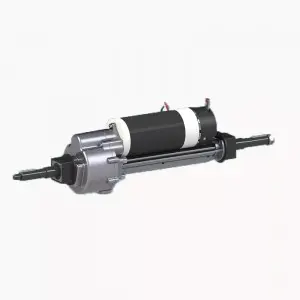Which Vehicles Mandate Electric Transaxles
In the rapidly evolving landscape of the automotive industry, the shift towards electrification is more pronounced than ever. Electric transaxles, a crucial component in electric and hybrid vehicles, are becoming increasingly prevalent. But which vehicles mandate electric transaxles, and what factors are driving this trend?
The Regulatory Push
One of the primary drivers for the adoption of electric transaxles is regulatory requirements. Governments around the world are implementing strict emissions standards to combat climate change and reduce air pollution. For instance, in the European Union, there are stringent CO2 emission targets for vehicles. By 2030 – 2034, the CO2 emission 限值 for new cars is set to drop significantly, and by 2035, the aim is to achieve zero – tailpipe emissions for new cars and vans.
In the United States, states like California have their own zero – emission vehicle (ZEV) mandates. These mandates require a certain percentage of vehicles sold by manufacturers in the state to be zero – emission vehicles, which often rely on electric transaxles. Manufacturers failing to meet these targets may face fines, creating a strong incentive for them to develop and produce vehicles with electric transaxles.
Electric and Hybrid Cars
Battery – Electric Vehicles (BEVs)
BEVs are entirely powered by electricity and thus rely heavily on electric transaxles. These vehicles use electric motors integrated with transaxles to transfer power from the battery to the wheels. For example, Tesla’s Model S, Model 3, Model X, and Model Y all feature advanced electric transaxle systems. The electric transaxle in a Tesla vehicle is designed to provide high – efficiency power transfer, enabling the cars to achieve impressive acceleration and long – range capabilities.
Hybrid Electric Vehicles (HEVs) and Plug – in Hybrid Electric Vehicles (PHEVs)
Hybrid vehicles, which combine an internal combustion engine with an electric motor, also make use of electric transaxles. In HEVs like the Toyota Prius, the transaxle plays a crucial role in coordinating the power from the engine and the electric motor. The Prius’s transaxle is designed to seamlessly switch between the two power sources, optimizing fuel efficiency.
PHEVs, such as the Chevrolet Volt (now discontinued but a significant example in the past), operate on battery power for a certain range and then switch to a combination of battery and engine power. The GM “Voltec” 4ET50 multi – mode electric transaxle in the Volt was a key component that enabled different operating modes, improving electric driving range and reducing fuel consumption.
Commercial Vehicles
Light – Duty Commercial Vehicles
Light – duty commercial vehicles, including delivery vans and small trucks, are also seeing a growing adoption of electric transaxles. As companies look to reduce their carbon footprint and operating costs, electric versions of these vehicles are becoming more popular.
For example, the Ford E – Transit Custom is an all – electric light commercial vehicle. It features an electric transaxle that provides power to the wheels, offering a payload capacity of 620 kg and a range of up to 430 km. Another example is the BYD eVAL, which has a 700 – kg payload capacity, a 300 – km range, and is equipped with an electric transaxle for its front – wheel – drive system.
Heavy – Duty Commercial Vehicles
The heavy – duty truck segment is also making significant strides in electrification, with electric transaxles playing a pivotal role. Mercedes – Benz’s eActros 600, a heavy – duty long – haul electric truck, is a prime example. It is based on an 800V high – voltage platform and is equipped with an integrated electric drive axle. This electric transaxle, with its high – integration, high – transmission – efficiency, and high – lightweight characteristics, enables the vehicle to achieve a range of 500 km. The eActros 600′s electric transaxle, which integrates dual motors and a four – speed gearbox, provides a peak power of 600 kilowatts (816 horsepower) and a continuous power of 400 kilowatts (544 horsepower), ensuring strong acceleration and good driving performance.
Specialty and Niche Vehicles
Electric Buses
Electric buses are becoming increasingly common in urban transportation systems. These buses are required to meet strict emissions and noise – reduction standards in many cities. Electric transaxles are used to power the wheels of these buses, providing smooth and efficient operation. For example, in some European cities, electric buses equipped with advanced electric transaxle systems are being deployed to reduce emissions in congested urban areas.
Off – Road and Special – Purpose Vehicles
Certain off – road and special – purpose vehicles are also adopting electric transaxles. For instance, some mining vehicles are being electrified, and electric transaxles are used to transfer power to the large wheels or tracks of these vehicles. These transaxles are designed to withstand the harsh operating conditions of mining environments while providing the necessary torque for heavy – duty operations.
In conclusion, a wide range of vehicles, from passenger cars to commercial trucks and specialty vehicles, are mandating or increasingly adopting electric transaxles. Regulatory pressures, the need for improved efficiency, and a growing focus on reducing emissions are the main factors driving this trend. As technology continues to advance and costs continue to come down, we can expect to see an even greater prevalence of electric transaxles in the automotive industry.
Post time: Aug-29-2025


